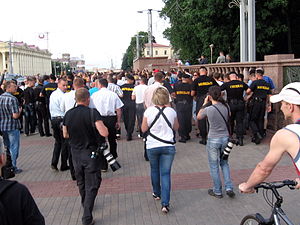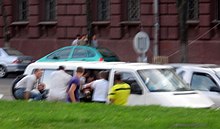2011 Belarusian protests
 From Wikipedia - Reading time: 9 min
From Wikipedia - Reading time: 9 min
You can help expand this article with text translated from the corresponding article in Russian. (March 2013) Click [show] for important translation instructions.
|
You can help expand this article with text translated from the corresponding article in Ukrainian. (March 2013) Click [show] for important translation instructions.
|
| 2011 Belarusian protests | |
|---|---|
| Part of the Belarusian democracy movement | |
 Security forces pushing back protesters in Minsk, 15 June 2011 | |
| Date | 8 June – 12 October 2011 (4 months and 4 days) |
| Location | |
| Caused by |
|
| Goals |
|
| Methods | Political lobbying, public rallies, demonstrations, riots, industrial action. |
| Casualties and losses | |
| 18 injuries, including 2 police officers | |
The 2011 Belarusian protests were a series of peaceful protests by demonstrators in Belarus demanding the resignation of current Belarusian president Alexander Lukashenko, who had been the president of Belarus since 1994.[1][2] Belarus is an authoritarian state, and in May 2011 presidential candidate Andrei Sannikov was sentenced to five years in prison for taking part in the 2010 presidential election. Lukashenko claimed he won with almost 80% of the vote.[3]
Background
[edit]Much of the protesting fervor stemmed from a rapidly degrading economy that Belarus had been facing in the months before the protests.[4]
Protests
[edit]8 June
[edit]- In the first protest actions, at 7 p.m. on Kastrychnitskaya Square in Minsk, about 400 people gathered together in response to an appeal on the Internet to come to the main squares of cities to take part in the silent protest action "Revolution Through the Social Network". At the beginning of the action, the participants stood disorganized in small groups, occupying a significant part of the square. At around 7:10 p.m., the participants began to applaud spontaneously, after which a dense ring of protesters and journalists formed in the center of the square. People standing in the center of the ring sang songs and played the guitar.
- The action was watched by members of the special forces police regiment, as well as people with civilian walkie-talkies. Special forces were on duty not far from the crowd, while the plain clothes officers were constantly in the center of the event, without interfering in the course of the peaceful action. Around 7:45 p.m., the participants began to disperse. Only a few dozen people remained on the square.
- In Mogilev, on Lenin Square near the House of Soviets, about 80 people gathered at the call. Young people prevailed among the participants of the action. According to some participants, they were largely inspired by the action "Stop Petrol," held the day before in Minsk.
- About 200 people gathered on Lenin Square in Brest. The participants of the action did not shout out slogans and were without banners. They were walking and talking. Some of the passing cars were signaling in support of the participants' action. The action was observed by two people in police uniforms, as well as by security forces. The action lasted from 18:50 to 19:30 and ended with applause.
- About 200 people gathered on Lenin Square in the center of Gomel. The action was attended by famous Gomel musicians, representatives of informal youth movements.
29 June
[edit]Hundreds of people gathered in Minsk, the capital of Belarus, to protest against the rule of Alexander Lukashenko. Unlike previous demonstrations, the protesters this time just simply applauded. It was not long before people were forced onto police buses, and about 40 were detained.
3 July
[edit]On Belarusian independence day, about 3000 demonstrators took part in a "clapping protest" in the main square of Minsk, in which protesters clapped instead of chanting slogans. Plain clothed police later came, and arrested many protesters, including a one-armed man for clapping, and a deaf mute accused of shouting anti-government slogans.[5] Lukashenko and the state police were awarded the 2013 Ig Nobel Peace Prize for these actions.[6]
Following the protest on 3 July 2011, activists widened their tactical approach of civil disobedience by distributing videos of police brutality to random citizens, in order to help garner sympathy and bolster the global critiques of the authoritarian government.[7]
13 July
[edit]
Hundreds of people showed up in Minsk with cellphones set to go off at 8 am, in gesture to tell people to "wake up". Several dozen people were arrested by the police.[8]
Reaction
[edit]The government began blocking social networking sites such as Twitter and Facebook.[9][10]
On 29 July, the government banned assemblies and gatherings, making them illegal.[11]
See also
[edit]- Belarusian presidential election, 2010
- Jeans Revolution
- Orange Revolution
- List of protests in the 21st century
References
[edit]- ^ "Belarus: Lukashenko vows to quell 'revolution plot'". BBC News. 3 July 2011.
- ^ Tovrov, Daniel (4 July 2011). "Hundreds Arrested in Belarus' Silent Protest".
- ^ Marson, James (14 May 2011). "Belarus Presidential Runner-Up Sentenced to Prison". The Wall Street Journal.
- ^ "Lukashenko nears crunch time, says Belarus opposition". Reuters. 6 July 2011. Archived from the original on 25 May 2012.
- ^ Weir, Fred (8 July 2011). "In Belarus, one-armed man arrested for clapping". The Christian Science Monitor. Retrieved 10 October 2014.
- ^ "Winner if the Ig Nobel Prize". Annals of Improbable Research. Retrieved 10 October 2014.
- ^ Motlagh, Jason (12 July 2011). "Protesters broaden tactics as Belarus cracks down" – via Christian Science Monitor.
- ^ "100 detained in Belarus protests – NEWS FROM BELARUS". Archived from the original on 17 February 2012. Retrieved 30 July 2011.
- ^ Mary. "Belarus blocks Twitter and Facebook in bid to prevent protests".
- ^ Balmforth, Richard (3 July 2011). "UPDATE 2-Belarus police arrest protesters at anti-Lukashenko rallies". Reuters.
- ^ "Belarus Passes Law Against Silent Protests". Archived from the original on 14 August 2011. Retrieved 30 July 2011.
 KSF
KSF